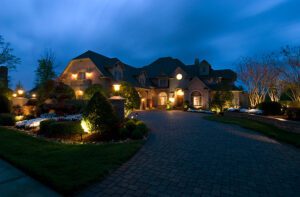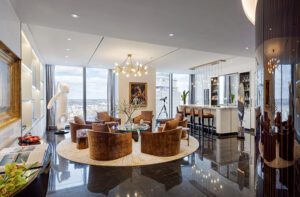Rewilding in Brookline: Transforming a Landscape for Biodiversity and Sustainability
November 11, 2024
With a whole lot of vision, engineering, and insight, a Brookline landscape goes from leafless to lush.
Text by Tovah Martin Photography by Matthew Cunningham

Transforming a Suburban Lot into a Native Woodland Paradise
It was the sweetest suburban one-third acre that ever begged to be transformed into a wilderness. Wedged between a gravel parking lot and a bucolic reservoir, with a thirty-foot grade change and virtually no topsoil, the land had infinite issues, and it was up to Matthew Cunningham Landscape Design to turn it into a fully realized leafy forest.
Paul and Hildete Clayton had owned the Brookline property since 1989, but getting approval to build their dream home took decades. From the get-go, the Claytons strove for a partnership with the land. Hildete is from Brazil and comfortable with jungle-thick surroundings. Paul grew up in Brookline but wanted to forge a Thoreau-inspired paradigm “living in alignment with nature.” When Paul found Matthew Cunningham, they formed an instant bond, and the “garden” began to take shape in 2014.
The adventure is designed to unfold with a complex of stepping stones and pathways meandering through a dense woodland of native trees to the front door via a boardwalk bridge. “Nature is primary,” explains Paul. “There is no obvious straight pathway to the front door; you have to navigate around the plants.”
A Dynamic Landscape: Native Plants and Sustainable Design
Cunningham designed in vertical layers starting with the ground level and continuing upward with the understory and canopy strata providing privacy and infinite opportunities for wildlife/human cohabitation. From the onset, the land’s evolution was considered, says project manager and MCLD principal Ryan Wampler. “With this project, the cycle of nature is paramount,” he says. “It’s constantly evolving. The ecology of a forest is that plants grow, they shade out plants below, and new species take root. Nature is never static, it’s dynamic.”
In this ecosystem, there is no lawn, and paving, which covers only ten percent of the lot, is permeable. “Ninety percent of the plants used are regionally native; they’ve evolved to endure in our climate,” says Cunningham. Perennials were chosen for their transitional roles in the landscape’s maturity cycle. “We have to start thinking about biodiversity and habitat,” Cunningham continues. “It’s a new narrative, but so much of this project emanates from everyone’s willingness to think out of the box.”
Stewardship and Recognition: A Collaborative Success Story
The landscape earned an Excellence Award from the Boston Society of Landscape Architects in 2022, and the Claytons have fully embraced their role as stewards. “Humans are often thought of as the bad guys in ecology,” says Paul, “but there are critical roles we can play, like making soils healthier to successfully create habitat.” It turns out vision, collaboration, and knowledge can redefine wild as a forest with forethought.
Project Team
Landscape design: Matthew Cunningham Landscape Design
Exterior architecture: Myles Alan Katz Architect
Interior architecture and design: Kligerman Architecture & Design
Share
![NEH-Logo_Black[1] NEH-Logo_Black[1]](https://b2915716.smushcdn.com/2915716/wp-content/uploads/2022/08/NEH-Logo_Black1-300x162.jpg?lossy=1&strip=1&webp=1)













You must be logged in to post a comment.